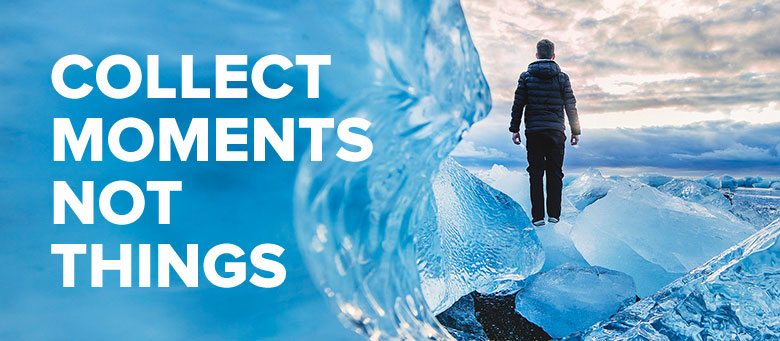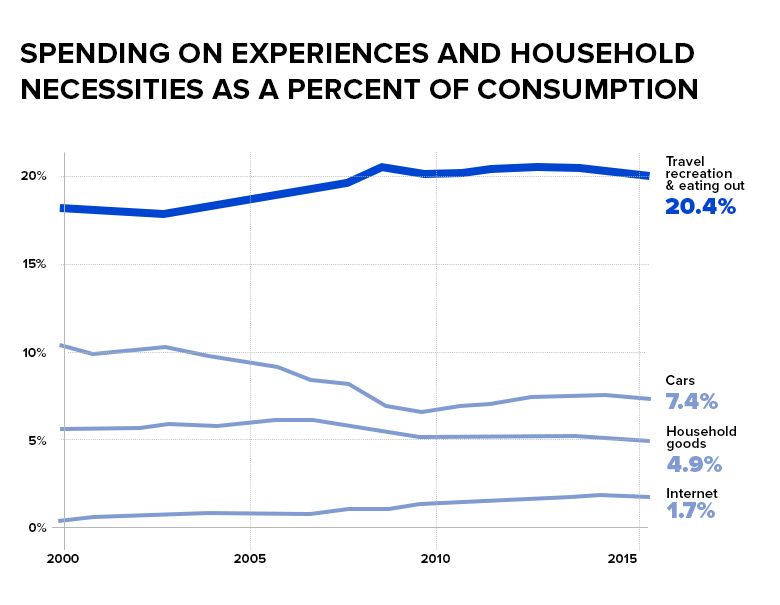The change in consumer behaviour was, in part, affected by the recent economic crisis: people reduced their spending and focused less on buying things, and the mere shopping itself is now less of a fun past-time. But it’s not just about that. You’ve probably at least once come across some ‘motivational picture’ on the Internet with the similar message:

Understanding this attitude is key to predicting today’s customers’ expectations, and this is what retailtainment is about: giving the customer moments. This trend can be easily traced throughout media with countless articles like this one telling people to invest in experiences rather than things, because the happiness from buying is fleeting, whereas memories are there to stay.
Studies show that 72% of millennials choose experiences over material things as a way of ‘purchasing happiness’. The trend is further fuelled by the abundance of social media and apps that allow people to show off these precious experiences; they also prompt the users to do so, either provoking the thirst for recognition (likes to the cool people with interesting lives), fear of missing out, or competitiveness.

Source: fortune.com
There are countless ways of appealing to new customers and engaging to come and stay in the store. Let’s go over some common forms of retailtainment.
Services and lifestyle destinations in the department stores
This approach has a number of benefits. Firstly, it slows down the pace which improves the shopping experience and makes it more comfortable for the exhausted, constantly pressured by deadlines and responsibilities city-dwellers. A bookshop where you can read while having a cup of coffee or a lunch looks like a fine way to spend an afternoon, it almost imitates the hygge idea of cuddling up at home with a book and some cocoa with marshmallows. From the book store’s perspective, they get you to stay with them for lunch, or maybe even spend a day at the store. Similarly, beauty and hair salons are offering beverages, clothing and cosmetic stores serve some Prosecco etc. The idea is to turn the trivial act of acquisition of goods into a fun all-day experience, a sort of ‘hanging out’.
The social chain
Adding the social element is about giving a consumer a reason to come to the store to take selfies and share them with friends, helping them make memories they want to share. This can be done by installing permanent in-store entertainment, for example. Not necessarily something as extravagant as adding a $12 million, 40,000-square-foot Lego Discovery Centre and a 10,000-square-foot miniature golf course made with Legos, but in a similar spirit.
Another way is to hold events on-site. It could be concerts, holiday celebrations, yoga classes, education about your product, anything that counts as an experience for the consumer. The retailer needs to study their audience and identify the types of events they go to – then hold the similarly appealing activities on-site. So, putting it simply, if you sell yoga pants or running shoes holding yoga classes or organising a charitable marathon is a good way to reach out to your customers.
The tech way
There are a lot of ways of incorporating shopping into leisure through the use of technology. It can be something relatively simple, like RFID keys in Target’s Wonderland, or something very hi-tech like Virtual and Augmented Reality.
You could use AR and/or facial recognition technologies to create an app which helps your customer try your goods on (in a realistic way, not the old-fashioned cut-out static pictures slapped on top of the uploaded user’s picture). Or you could install VR headsets in your flagship stores, because ‘these days you can’t just wait for people to come into your store and try on jackets, you have to provide entertainment’. Marketing your stores through gamification is another strategy.

Retailtainment in action: real-life examples featuring big brands
With retailtainment, retailers are shifting their focus towards immersive shopping and customer experience, as a contrast to the features-and-benefits approach. Several big brands have already nailed this approach, resulting in an entirely new level of customer engagement.
OakLabs is pioneering the smart mirror trend. These multi-purpose mirrors can interact with customers, collect in-store data and provide information on stock inventory. Prices and inventory are transparent on the internet but, in-store, customers have to go through a salesperson in order to get a different size or colour. Interactive mirrors can provide an easy interface for finding information on which items are available, as well as offering recommendations by scanning the RFID tags of items the customer already has in the fitting room.
One more example of big businesses using data to enhance the retail experience is Farfetch. Their retail Store of the Future in London is an excellent example of retailtainment in action. Connected clothing racks, touch-screen-enhanced mirrors and sign-in stations, pulling data collected online to use in-store, help engage the customer and provide valuable customer insight for the sales assistants.
The new science of customer emotions
An example from the Harvard Business Review: “After a major bank introduced a credit card for Millennials that was designed to inspire emotional connection, use among the segment increased by 70% and new account growth rose by 40%”.
The very first step in identifying the right way to engage your audience is, unsurprisingly, studying them. The goal here would be to determine the emotional motivators of your customers – and use them as a leverage for engagement. The simplest way would be a simple observation and experimenting. A more sophisticated approach would involve in-house big data analytics and in-depth research, or one could invite consulting with expertise in the field.
Building the emotional connection with the customer becomes a daunting task included into companies’ general strategies. If this sounds like too big of a challenge for in-house tackling, turning to a technology partner is always an option: our professionals will provide you with proper tools to analyse your audience, advise you on viable types of retailtainment for your clients – and will develop it for you.
Let us know if the concept of retailtainment resonates with you we will devise the solution that works best for your business.
Related Insights

















